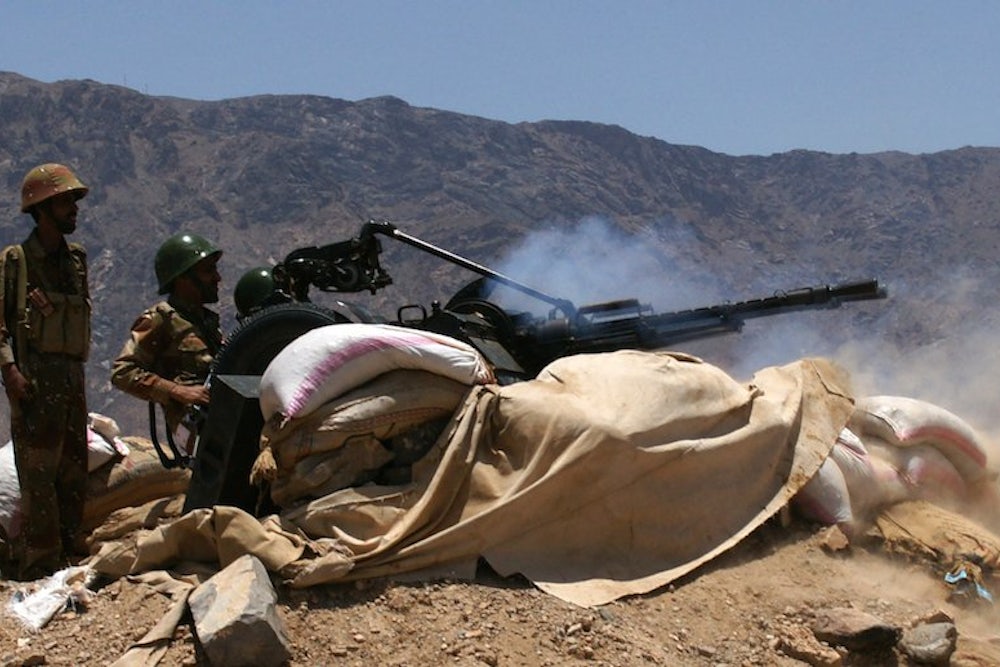Just a few months ago, the Obama administration was describing the U.S. counterterrorism campaign in Yemen as a success. "[The] strategy of taking out terrorists who threaten us, while supporting partners on the front lines, is one that we have successfully pursued in Yemen ... for years," the president said in a September 2014 statement. But recent events in that country raise doubts about that success. On Friday, the Houthi rebels—who gained control of the capital Sana’a last month and forced the country’s president, Abd-Rabbu Mansour Hadi, to resign—announced plans to dissolve Parliament in a Constitutional Decree.
According to The Guardian, the Pentagon is now unable to monitor the $400 million worth of military equipment provided to Yemen over the last decade, including tanks and artillery, and the Houthis reportedly control the Yemeni military's bases and arsenal. Should the group consolidate this control, it would have profound implications for America’s counterterrorism campaign in the country that's home to Al Qaeda in the Arabian Peninsula (AQAP). Many terrorism analysts consider the group, which took credit for the Charlie Hebdo attacks in Paris last month, to be Al Qaeda’s most dangerous branch. The group's numbers have more than tripled in recent years, growing from 300 to around 1,000 fighters since 2009, despite hundreds of drone strikes targeting the militants. In various attacks since a 2011 offensive in southern Yemen, AQAP has seized heavy weapons, armored vehicles, and tanks while overruning Yemeni military base.
While the Houthis—composed of Zaydis, a Shiite offshoot, and whom the U.S. believes are backed by Iran—includes “Death to America!” among its chants, the West has seen them as a counterweight to the more threatening AQAP. But as BuzzFeed’s Gregory D. Johnsen, a Yemen expert, wrote Friday, “AQAP will likely attract more recruits as fighters look for a force to counter the rebels. And it is exactly this scenario that worries U.S. officials: a collapsing Yemen, a growing al-Qaeda, and no allies on the ground.”
What has transpired in Yemen, specifically the uncertainty over who is controlling the Yemeni military’s arsenal, highlights the risks of providing material to state security forces or rebel groups in corrupt and politically unstable countries. This has been a persistent problem for the U.S., including during the so-called war on terror. Back in 2009, The New York Times examined a sample of ammunition markings from the rifle magazines of dead Taliban insurgents and found that more than half were identical to the weapons provided by the U.S. to the Afghan military. Just last year, a report from the Special Inspector General for Afghanistan Reconstruction (SIGAR), a government watchdog, found that around 40 percent of the small arms shipped to Afghanistan—hundreds of millions of dollars worth—were unaccounted for. The most common explanations for the missing weapons are theft and corruption.
In 2011, the Obama administration gave the green light to Qatar to provide arms to Libyan rebels challenging Muammar Gaddafi's regime. By the end of the 2012, the U.S. was alarmed over evidence that its Gulf ally was providing those weapons to more hardline groups, including Islamic militants. Some of those arms would eventually make their way to extremist groups in Mali and Syria.
More recently, Islamic State (ISIS) militants gained access to U.S.-provided heavy weaponry in Iraq after taking over military bases in the northern city of Mosul. Humvees and U.S.-made troop carriers were soon seen on the battlefield in Syria. The Obama administration has been tepid in its support of the Syrian opposition because of a fear that lethal aid to moderate rebels fighting Syrian President Bashar Al Assad would end up in the hands of more radical groups. In the end, the most radical group battling the Syrian government—ISIS—did indeed get their hands on American materiel, ableit by overruning Iraqi military bases rather than colluding with fellow rebels.
As the latest developments in Yemen show, arming fragile states and providing lethal aid to rebel groups are risky and should be approached with caution. Otherwise, U.S. policy could end up fueling the very conflicts it seeks to end.
